Compiled by Geoff Goodall
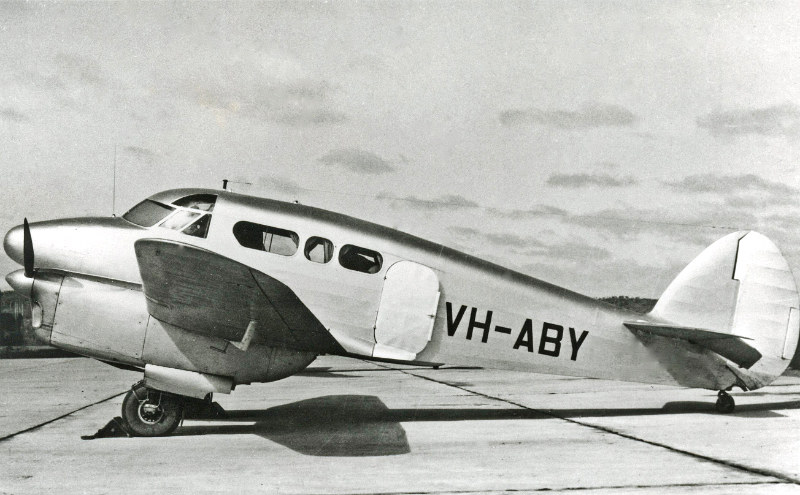
Australian-born Edgar Percival had enjoyed success in England, manufacturing his range of Percival Gull monoplanes. During 1936 he began design work for Percival Aircraft Ltd's first twin engined aircraft type. It was to be a low wing cabin aeroplane available in two versions, the Percival Q.4 with Gipsy Major engines to carry four passngers, and the Q.6 with Gipsy Six engines to carry six passengers. The Q.4 was not built, but work went ahead on the larger model Q.6.
It was of wooden construction, the fuselage being a ply box with fabric covering. Dual controls were provided for the two front seats. The prototype was first flown by Percival at Luton in September 1937 and production commenced with fixed undercarriage enclosed by streamlined fairings. Retractable undercarriage was offered as an option, but only four were built with this feature. Captain P.G. "Bill" Taylor, Australian pioneering pilot and aerial navigator was Edgar Percival's agent for Australia at that time. Taylor placed the first order for a retractable landing gear model, for which registration VH-ABL was allocated - but after ensuring widespread newspaper coverage for the new Percival twin engined type, he cancelled his order the following year and it remained in England, diverted to a RAF order. A total of 27 Percival Q.6s were built, including seven for the RAF,

The tragic crash of ANA DC-2 VH-UYC Kyeema at Mount Dandenong on 25 October 1938 descending in cloud into Essendon without radio aids embarrassed the Government into action. Funds were immediately freed to allow the Guinea Airways Lockheed 10A VH-AAU to be chartered and calibration began, allowing the Lorenz beams to be commissioned for airliner use. But the CAB needed its own calibration aircraft. A proposal to purchase a Lockheed was turned down by the Minister for Defence who insisted it must be a British aircraft. The only type offering anything like Douglas airliner performance was the Percival Q.6 retractable gear option and approval given for the purchase of one aircraft plus spares package. CAB had become DCA by the time the Percival arrived in Melbourne by sea from Britain in June 1939. From the start the Q.6 was found to be unable to carry the calibration gear, but the Department had quietly arranged a replacement.
In a surprising move, in early 1939 the Australian Government purchased the ship Wyatt Earp, Northrop Delta NR14267 and an Aeronca float plane after their use on the American Lincoln Ellsworth's Antarctic Expedition. DCA recognised the potential of the all metal Delta which became VH-ADR and was delivered to DCA at Essendon 16 June 1939, the same week as the Percival. DCA's Q.6 VH-ABY was used for some calibration duties but mostly as a fast transport for Departmental staff.
| .37 |
Percival Q.6 with rectactable undercarriage option ordered by Australian Percival agent Captain P.G.Taylor. |
| 11.37 |
Taylor sailed from Australia to England on a business trip, during which he visited Percival Aircraft Ltd in December to inspect the new Q.6 type |
| 3.5.38 |
Australian Civil Aviation Board allocated registration VH-ABL to P.G.Taylor's Percival Q.6 |
| C/n Q.25 allocated by Percival to this order |
|
| 6.38 |
Q.25 construction completed at Luton with standard fixed undercarriage. This would be modified to become the first Q.6 with retractable landing gear. |
| 30.6.38 |
Test flown with fixed undercarriage. |
| Retractable undercarriage units installed. De Havilland constant-speed metal propellers. | |
| Issued
to the Aeroplane and Armament Experimental Establishment, RAF
Martlesham Heath for evaluation of the retractable undercarriage
variant, for civil certification |
|
| 10.9.38 |
Damaged landing RAF Martlesham Heath, loss of effective elevator control suspected. Further testing required |
| Repaired by Percival Aircraft Ltd at Luton |
|
| 12.38 |
Returned to A&AEE Martlesham Heath for continued testing |
| C/n Q.34 allocated by Percival to VH-ABL |
|
| Q.34 construction completed at Luton: rectable undercarriage, incrreased elevator area, De Havilland constant-speed metal propeller |
|
| 2.39 |
Test flown at Luton, all silver with marking VH-ABL |
| 2.39 |
British CofA issued as VH-ABL: P.G.Taylor, Sydney, NSW Australia |
| Australian order cancelled |
|
| Q.34 now reallocated by Percival to RAF order as P5638 |
|
| 9.5.40 |
P5638 delivered from Luton to RAF Northolt |
| 24.7.40 |
P5638 issued ex Northolt to No.24 Squadron, as personal transport AOC-in-C Coastal Command |
| 6.6.43 |
Issued Royal Navy Air Station Donibristle, Scotland |
| 16.6.43 |
Damaged, struck a hedge when tailwheel seized while taxying at RAF Ratcliffe. |
| 13.7.43 |
Struck off charge at No.65 Maintenance Unit, RAF Blaby |
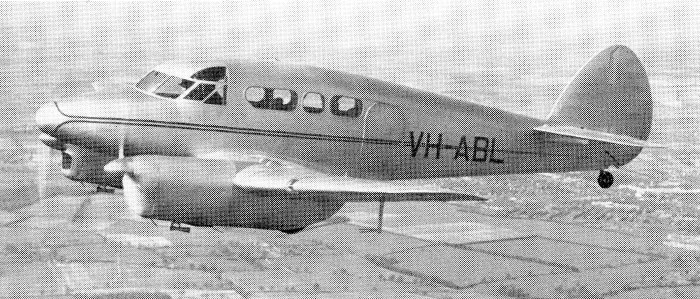
| .38 |
Built by Percival Aircraft Ltd at Luton Airport, Beds. C/n Q.35 Model Q.6 retractable undercarriage, De Havilland constant-speed metal propellers |
| Ordered by Civil Aviation Board, Department of Defence, Melbourne Vic |
|
| The CAB was replaced in March 1939 by a newly formed Department of Civil Aviation. | |
| 16.3.39 |
Percival Aircraft Ltd invoice to DCA: £6252 (Stirling) "packed ex London port" |
| 4.39 |
Test flown Luton marked VH-ABY, |
| 27.4.39 |
British CofA issued: VH-ABY Civil Aviation Branch. Australia |
| Dismantled and packed for shipping to Australia | |
| 12.6.39 |
Arrived Melbourne as cargo on board S.S.Wairangi |
| 6.39 |
Assembled and test flown at RAAF Laverton, then ferried to its base Essendon Aerodrome, Melbourne |
| 6.39 |
Flight trials for issue of first-of-type Certification. An internal DCA memo dated 28 June 1939: "The Q.6 with pilot, full tanks and no radio has a payload of 307 lbs, equivalent to one and a half passengers. Weight of radio equipment required for Public Transport aircraft totals 316 lbs, so that to be of general use to the Department complete radio cannot be carried. Recomend the Q.6 be fitted only with radio compass which includes receiver capable of operating on all communication frequencies." |
| Fitted with radio calibration equipment to test the signals from Lorenz radio range beacons being installed by DCA along main airline routes. | |
| 20.7.39 |
After modifications
at Essendon test flown by DCA Superintendent of Flying Operations Dave
Ross and Senior Air Inspector T.E.Johnson. |
| 20.7.39 |
Registered VH-ABY: Department of Civil Aviation, Melbourne Vic |
| 20.7.39 |
Australian CofA issued at Essendon |
| 7.39 |
VH-ABY will be fitted with an external battery plug of similar design to that used by Qantas DH.86s. |
| The Percival replaced the Department's GAL Monospar VH-UAZ. A June 1939 memo stated: "The Monospar is now of no further use to the Department and it is recommended that it be offered for sale to the aero clubs." |
|
| 27.6.40 |
DCA Senior Flying
Inspector Arthur H. Affleck submitted a report on his recent flight to
Perth and return in VH-ABY. He experienced battery problems, worn
fabric, noise in cabin from a flapping metal housing and poor general
appearance of the aircraft. He recommended the aircraft be resprayed
with aluminium dope to cover the various patches in the present colour
scheme. Director-General A.B. Corbett approved remedial action to be
taken at Essendon. |
| 21.7.40 |
VH-ABY
departed Essendon on an around-Australia inspection tour of aviation
facilities, flown by the Minister for Civil Aviation, James
V.Fairbairn, an experienced pilot. He was accompanied by professional
aerial photographer John T. Harrison to record their findings. Flew
Essendon-Sydney-Brisbane-Darwin-west coast- Perth-Essendon. Returned to Essendon on 1 August 1940 via a stop at the Fairbairn farming property at Mount Elephant Vic where Fairbairn had kept his DH.90 Dragonfly VH-ADG prior to its impressment by the Government under WWII regulations |
| From Ben Dannecker: "My
old friend John Harrison who had flown around Australia with Fairbairn
in the Percival Q.6 VH-ABY told me a bit about Fairbairn. He was a WW1
pilot with an infirmity to his left arm. Fairbairn always flew the Q.6
from the right hand seat, meaning that Harrison, with no flying
experience at all other than as a passenger, flew the entire trip in
the left hand captain's seat! We often discussed that Canberra
RAAF Hudson crash that killed Fairbairn and the other brass, and the
rumour that Fairbairn was flying the aircraft - and what his left arm
impairment might have played in that fateful misjudged tight turn on to
finals for RWY 30." |
|
| 9.40 |
Inspection report: airframe time 240 hours |
| VH-ABY
escaped Government
impressment for RAAF Communication Flights because of its essential
calibation duties for airline and military aircraft during WWII. Under
wartime regulations for civil aircraft it was repainted in camouflage. |
|
| 9.41 |
Affleck
flew VH-ABY from Essendon to Coen, far north Queensland carrying DCA
accident investigators to the crash site of DH.80 Puss Moth
VH-UQL. Again on return to Melbourne, Affleck submitted a report
critical of the Percival's maintenance standards. Gordon Berg, DCA
Chief Aeronautical Engineer added to his report: "The disgraceful condition of this aeroplane has proved very damaging to the prestige of the Department." |
| 6.42 |
Annual CofA renewal at Essendon |
| 7.42 |
Arthur Affleck flew VH-ABY to King Island, south of Melbourne. Arthur described the episode in his book "The Wandering Years": "In July 1942 I was dug out of my office at very short notice and instructed to fly Roly McComb, our Controller of Ground Organisation, to King Island due to some problem down there. We made the trip in 90 minutes in the Departmental Percival Q.6 and found that the two runways were blown full of gaping craters. I assumed a Japanese or German aircraft operating from a submarine had done some very accurate bombing. I landed on one of the taxiways and parked alongside an ANA DC-2 which was covered with small dents and smothered in clods of earth. Then we learned the truth. In common with all other civil aerodromes considered to have stategic importance to the enemy, the runways had been mined by our Army engineers. The job was no sooner completed than some clot, wondering what the little red handle was for, pushed it. King Island was cancelled as an ANA stopping place on the regular Tasmanian services for some weeks to come." |
| 8.42 |
VH-ABY's radio equipment was a continuing problem. A DCA memo noted that the radio equipment in the Percival was supplied on a rental basis by Amalgamated Wireless Australia Ltd and that all maintenance was the responsibility of AWA. |
| 6.10.42 |
Damaged in forced landing at Essendon. Repairs were delayed due to the war situation |
| 8.4.43 |
Test flown Essendon after completion of repairs |
| 7.43-9.43 |
DCA agreed to a lease arrangement with Ansett Airways Ltd, Essendon Aerodrome, Melbourne Vic VH-ABY would be operated by Ansett Airways on its Melbourne-Hamilton Vic route during periods that the usual aircraft Airspeed Envoy VH-UXM was undergoing maintenance or otherwise unavailable. Ansett was unable to find any other replacement aircraft due to the war situation. |
| 7.43 |
To enable the aircraft to carry a commercial load, the right side pilot's control quadrant and rudder pedals were removed to allow that seat to be used for an additional passenger. |
| 30.7.43 |
Forced landing without damage at "Banongill" farm near Skipton Vic, while
operating an Ansett Airways Hamilton-Melbourne service. Forced landing
was caused by power loss on rough running starboard engine. Ansett agreed to meet the costs of a replacement engine. |
| 13.9.43 |
Starboard
undercarriage collapsed during landing at Hamilton Vic. on an Ansett
serice from Melbourne, no injuries to Captain L.E.Morey and passengers. Inspection
revealed the gear had not locked down because of a defective switch,
which resulted in DCA bearing the cost of repair. |
| 17.12.43 |
CofA renewed after repair. |
| In a letter to the
Airways Museum, Michael Keith Hornabrook, then aged 88, recalled his
school boy flights by Ansett Airways between Hamilton and Melbourne
during the war years usually in the Airspeed Envoy: "When in 1943 I first saw the slippery-looking low-wing Percival Q6 with its underslung in-line engines I likened it to a Scott & Black deHavilland air racer when compared to the usual Envoy. I enjoyed two trips in VH-ABY during September 1943. For the second flight I ensured that I was first to board and gain the seat beside the pilot. With weight a consideration, he might well have preferred an adult up front and the small eleven-year old back in the rear seat, but thankfully he did not. So I had a good view and worked the undercarriage lever for him. " |
|
| 24.1.44 |
VH-ABY was delayed at Townsville due unserviceable tailwheel |
| 11.7.44 |
CofA expired, parked in hangar at Essendon |
| 9.44 |
Internal DCA memos debate the cost of renewing the CofA at a time of wartime budget restrictions. The matter was sealed by the following file note dated 18.9.44: "The Department cannot afford not to have available an aircraft for testing of airway facilities. Although VH-ABY was used by the Department only for 47 hours in the 12 months ending 12/7/44, the flying that was actually done was essential; for instance, the aircraft was utilised in January for testing new radio ranges at Townsville and Cairns, tests which had to be performed for lining up the courses and checking their performances before the ranges could be available to civil operators. More extensive use would have been made of the aircraft if more departmental pilots had been available and also if there had not been such a stringent control of the use of petrol." |
| 11.44 |
CofA
renewal overhaul has commenced at Essendon. ANA advise they are unable
to carry out a fabric re-cover due to a shortage of fabric workers and
the amount of work at present in their workshops. |
| 10.1.45 |
CofA renewed Essendon |
| 3.46 |
The formidable DCA Director of Air Navigation and Safety, C.S.Wiggins decreed: "Percival VH-ABY flies only about 10 hours per year as it is unsuitable for Departmental duties. When we test radio ranges we obtain aircaft from the RAAF. I recommend that the Q.6 be passed to the Disposals Commissionfor sale." |
| 8.46 |
Percival Q.6 VH-ABY offered for sale by Commonwealth Disposals Commission in a disposals sales list. Quoted as c/n Q35, built 1939, airframe total time 1,013 hours. Fitted with Gipsy Six Series II engines. Seating for two pilots and 4 passengers. DCA has ruled that it can only be operated in Private Category. Located at DCA hangar at Essendon Airport. Closing date for tenders was 6.9.46 |
| 8.46 |
As a result of the disposals list, DCA received letter
from Mr. L.C. Tremaine of Whyalla SA asking if the aircraft could
be granted a licence for charter and joy flights. DCA replied that the
aircraft would only be permitted to operate in the private category,
which was a condition of sale. (Compilers note: Mr. Tremaine was connected with Gulf Aviation Services, Whyalla SA which operated two Fairchild 24s on charter and a scheduled service to Port Pirie. DCA's ruling is curious, given they operated the aircraft in the Airwork category. Such arbitary decisions were made in the post-war years when the Department was determined to restrict a profusion of small airlines operated by ex wartime pilots with inadequate operational, maintenance or financial support.) |
| 9.46 |
Sold through Commonwealth Disposals Commission to Wallace Stillard, Barooga NSW |
| Stillard was a wealthy farmer and hotel proprietor in the Cobram/Deniliqin district who
owned a variety of aircraft in the early post-war years: DH.60 Moth
VH-UAU, Westland Widgeon VH-UKE, Sopwith Pup VH-UCK, Moth Minor VH-AEM, Miles Falcon VH-ABT |
|
| 18.10.46 |
Handed over at Essendon and sale document from DCA to Wallace O. Stillard, "Marboc" farm,Cobram Vic |
| 18.10.46 |
CofA renewed at Essendon |
| 3.11.46 |
Badly
damaged landing at Corowa NSW. Stillard had flown from Nhill Vic and
landed on the airfield grass rather than runways due to crosswind.
Undercarriage struck a gravel heap overgrown with grass. |
| 12.46 |
Repairs
have commenced. By February 1947 the aircraft was at Essendon having
repairs and steel tubing work carried out by Air Operations Pty Ltd |
| 4.7.47 |
CofA renewed Essendon |
| 23.8.47 |
Stillard sold VH-ABY to W. John Meehan, trading as Geelong Airways, Belmont Common airfield, Geelong Vic Meehan traded his Waco YQC-6 VH-UVW and a Ryan STM for the Q.6 Stillard's diary for 23.8.47: "Arranged swap with John Meehan of Q6 for Waco, spare engine and prop, 1 Ryan, and £300: £150 cash and £150 in 3 months." John Meehan was a pre-war pilot who owned DH.85 Leopard Moth VH-ADV and Ryan STA VH-UYN. After RAAF service in 1945, Wing Commander Meehan established Geelong Airways as a training and charter business with Tiger Moths, Ryans and a Waco YQC-6 cabin biplane. He was also the President of the Geelong Aero Club. Meehan ferried RAAF disposals aircraft to Brown & Dureau Ltd's Belmont Common workshops for civil conversions for resale. |
| 26.8.47 |
Crashed in mountainous terrain near Wee Jasper NSW John Meehan and Wallace Stillard were flying from Sydney Airport to Geelong via Holbrook NSW. Stillard had purchased items including aircraft clocks from a Commonwealth Disposals Commission sale in Sydney. Meehan was pilot in command, having signed the weather forecast and pilot briefing before departure Sydney. VFR no radio flight, reported missing by Meehan's wife two days later when they failed to arrive at Geelong. |
| One of Australia's
largest aerial searches to that time failed to find any trace of the
aircraft. Initially RAAF Lincolns, Dakotas and Liberators were used,
later civil aircraft. John Meehan's brother Ross flew a Tiger Moth in
his own search. Wide press coverage generated many spurious sighting or
hearing reports from as far away as Tasmania.
Further interest was aroused when newspapers reported rumours that
Stillard was carrying £2000 cash, that figure changing several times. |
|
| An indication of
the length of the search is provided by Charles Miller, who in 1947 was
flying Ansons for Western Airways Passenger Services, Warrnambool Vic: “Gordon Howe and I made three trips to the little town of Benambra NSW because of rumours of the Q.6 being in the area. Everyone offered sightings, as we tried to plot a flight-path for the ill-fated aircraft. As it transpired, every report was wrong, as the Q.6 was never there. It went missing on 26 August 1947. We arrived at Benambra on 8 September in Anson VH-BAX to begin searching, criss-crossing the Snowy River and surrounding bushland for four days in vain. We were hired by the local publican and friends to come back and take them to the Melbourne Cup. This time we came in Anson VH-BFG on 1 November and flew them to Essendon. On 5 November, after the Cup program, we took them home. In the intervening period from our days there in September, on a distant mountain top, through binoculars, someone spotted possible aircraft wreckage, so on our third visit we flew over the site, only to find it was melting snow, so that was the last desperate attempt for the Q.6.” |
|
| 1.11.48 |
Wreckage located. The
remains of the aircraft and its two occupants were found by a group of
Duntroon Army cadets on a bush exercise in the Brindabella Ranges, 15
miles northwest of Canberra. |
| DCA
investigation determined that the
aircraft was 8 miles left of its direct track Sydney-Hobrook. It had
struck rising terrain under power, leaving a wreckage trail for some
distance up the slope from the initial impact site. Cause of accident:
visual flight continuing into non-visual conditions below minimum
terrain altitude. |
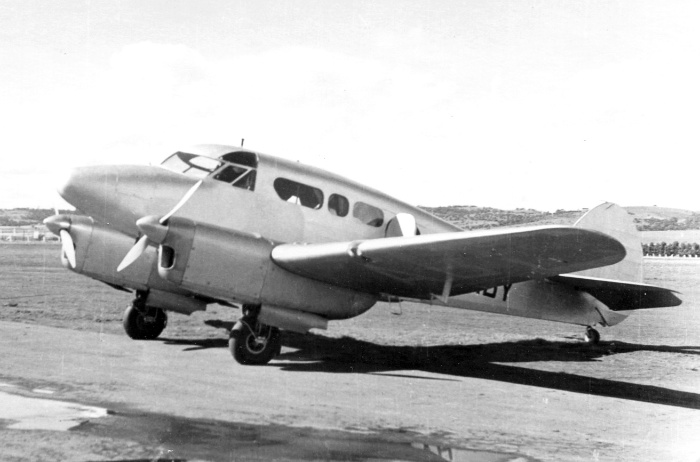

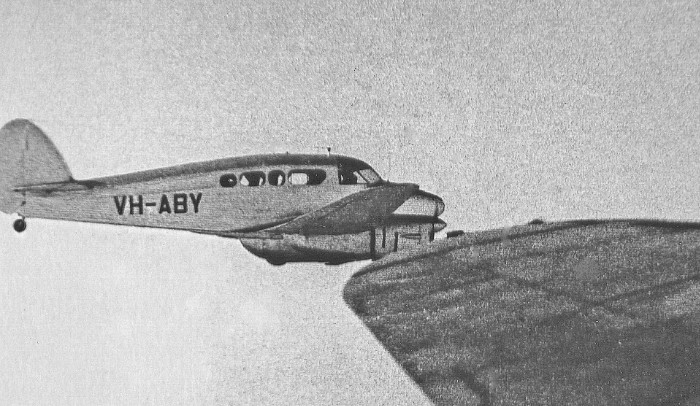
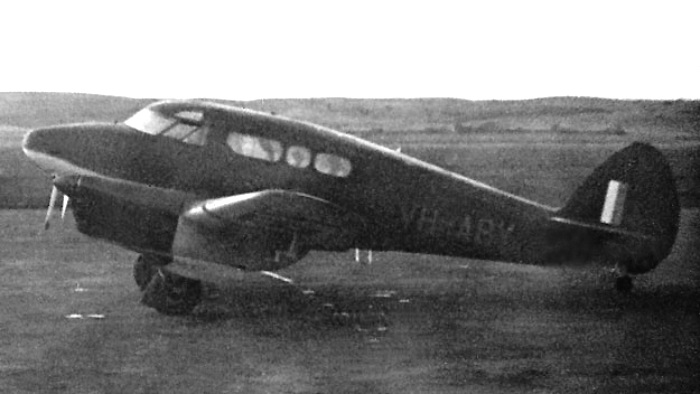
VH-ABY at Parafield 1942 in camouflage.
Photo by Alan Betteridge via Civil Aviation Historical Society

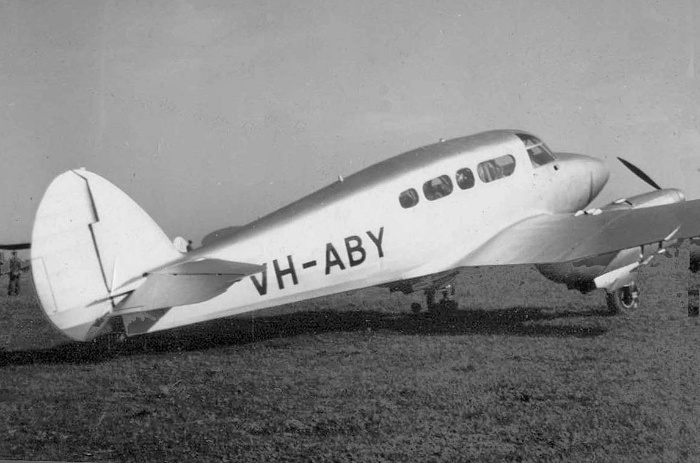
Photo by Bob Fripp
- Australian Civil Aircraft Register, Department of Civil Aviation, Melbourne: original hand-written ledgers
- DCA aircaft file VH-ABY, National Archives of Australia
- Airways Museum website: DCA aircraft fleet: Percival Q.6
- Flypast - A Record of Aviation in Australia, Neville Parnell and Trevor Boughton, CAA Canberra 1988
- The Wandering Years, Arthur H. Affleck, Longmans Green & Co, Melbourne 1964
- British Civil Aircraft Since 1919, Volume 3, A. J. Jackson, Putnam London 1974
- Percival Q.6 VH-ABY, Neil Follett, Aviation Heritage Vol.52 No.1 March 2021, Aviation Historical Society of Australia
- Percival Q.6, Mike Hooks, Air Britain Digest, Summer 1994, plus updates in Autumn 1994 & Winter 1994
My thanks to Neil Follett for his on-going assistance with this page.